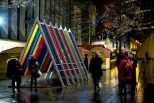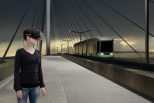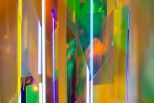The English artist Liz West in his latest site specific work explores light and color. Always her installations create…

“Forest of Light” installation that explores the idea of interaction and perspective; the darkened space is lit by towering cones of light that are designed to respond to the movements of the visitors.

They went into the forest and I traveled sublimated by the light and beauty. A forest composed entirely of light, created by the renowned Japanese architect Sou Fujimoto invited by COS clothing brand to create the installation that has bewitched visitors of Fuorisalone.
With fog and a waltz composed for the occasion, has recreated an immersive environment, mirrored walls where it was fascinating to imagine an infinite landscape, in which the conical reflectors become abstract trees, joining together to form a forest where one can observe the displacement of the light.

“People walk through this forest, as if drawn by the allure of light. Light and people interact with each other, its existence defines the other’s passage “- Sou Fujimoto
The forest effect recreated the spotlight from above in the form of trees. “These pulsating lights and constantly suffer the transience of nature. The people will wander through this forest, as inexplicably attracted to the light charm “Fujimoto writes. “Once that place was a theater, and the spotlight is a kind of homage to the past. They are used to connect fashion, space and nature as a form of architecture
The “Forest of Light” built by the Japanese was hosted at Cinema Arts, built in the 30s by the Italian architect Mario Cereghini. The location has inspired the work of Sou Fujimoto, who always explores some concepts related to interaction and perspective, as a good Japanese!

The dark space was lit by large cones of light, which completely interacted with the moving of visitors, making the process highly interactive. The spotlight abstract trees of a changing forest of light. Light and visitors interact with each other and this synergy creates a bond between fashion, the space and the forest, as a form of architecture. “




